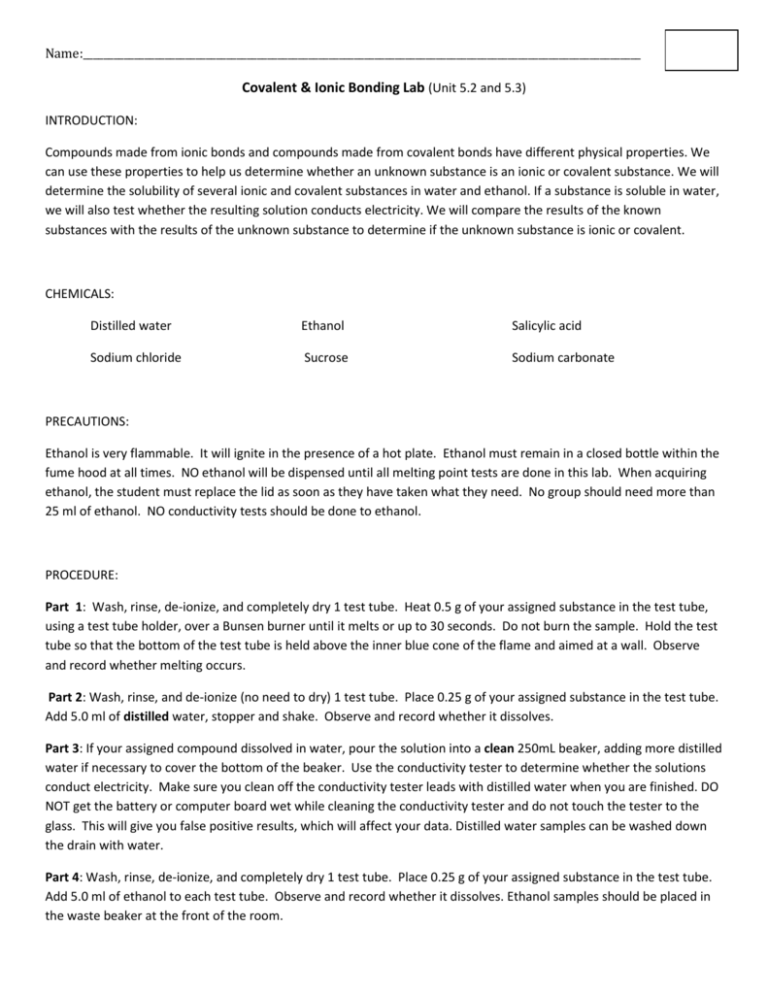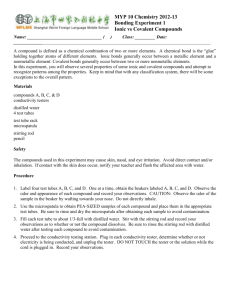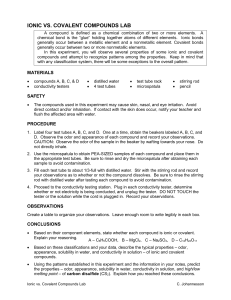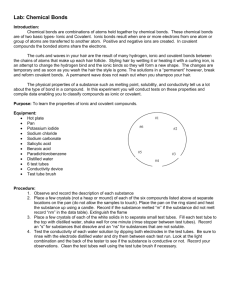Covalent and Ionic Bonding Lab
advertisement

Name:_____________________________________________________________________________________________________________ Covalent & Ionic Bonding Lab (Unit 5.2 and 5.3) INTRODUCTION: Compounds made from ionic bonds and compounds made from covalent bonds have different physical properties. We can use these properties to help us determine whether an unknown substance is an ionic or covalent substance. We will determine the solubility of several ionic and covalent substances in water and ethanol. If a substance is soluble in water, we will also test whether the resulting solution conducts electricity. We will compare the results of the known substances with the results of the unknown substance to determine if the unknown substance is ionic or covalent. CHEMICALS: Distilled water Ethanol Salicylic acid Sodium chloride Sucrose Sodium carbonate PRECAUTIONS: Ethanol is very flammable. It will ignite in the presence of a hot plate. Ethanol must remain in a closed bottle within the fume hood at all times. NO ethanol will be dispensed until all melting point tests are done in this lab. When acquiring ethanol, the student must replace the lid as soon as they have taken what they need. No group should need more than 25 ml of ethanol. NO conductivity tests should be done to ethanol. PROCEDURE: Part 1: Wash, rinse, de-ionize, and completely dry 1 test tube. Heat 0.5 g of your assigned substance in the test tube, using a test tube holder, over a Bunsen burner until it melts or up to 30 seconds. Do not burn the sample. Hold the test tube so that the bottom of the test tube is held above the inner blue cone of the flame and aimed at a wall. Observe and record whether melting occurs. Part 2: Wash, rinse, and de-ionize (no need to dry) 1 test tube. Place 0.25 g of your assigned substance in the test tube. Add 5.0 ml of distilled water, stopper and shake. Observe and record whether it dissolves. Part 3: If your assigned compound dissolved in water, pour the solution into a clean 250mL beaker, adding more distilled water if necessary to cover the bottom of the beaker. Use the conductivity tester to determine whether the solutions conduct electricity. Make sure you clean off the conductivity tester leads with distilled water when you are finished. DO NOT get the battery or computer board wet while cleaning the conductivity tester and do not touch the tester to the glass. This will give you false positive results, which will affect your data. Distilled water samples can be washed down the drain with water. Part 4: Wash, rinse, de-ionize, and completely dry 1 test tube. Place 0.25 g of your assigned substance in the test tube. Add 5.0 ml of ethanol to each test tube. Observe and record whether it dissolves. Ethanol samples should be placed in the waste beaker at the front of the room. Name:_____________________________________________________________________________________________________________ DATA: SUBSTANCE SALICYLIC ACID SUCROSE SODIUM CHLORIDE SODIUM CARBONATE UNKNOWN MELTING SOLUBILITY IN WATER SOLUBILITY IN ETHANOL CONDUCTIVITY (IN WATER ONLY) POST LAB QUESTIONS (answer in complete sentences): 1) Ionic compounds have at least one metal bonded to at least one non-metal. Covalent compounds are made of only non-metals. Look at the following formulas and decide whether the compounds are ionic or covalent. Salicylic acid: C7H6O3 Sucrose: C12H22O11 Sodium Chloride: NaCl Sodium Carbonate: Na2CO3 2) Based on the information in the data table and question 1 above, what physical properties are characteristic of ionic compounds? 3) Is the unknown substance ionic or covalent? How do you know?






